Mining companies
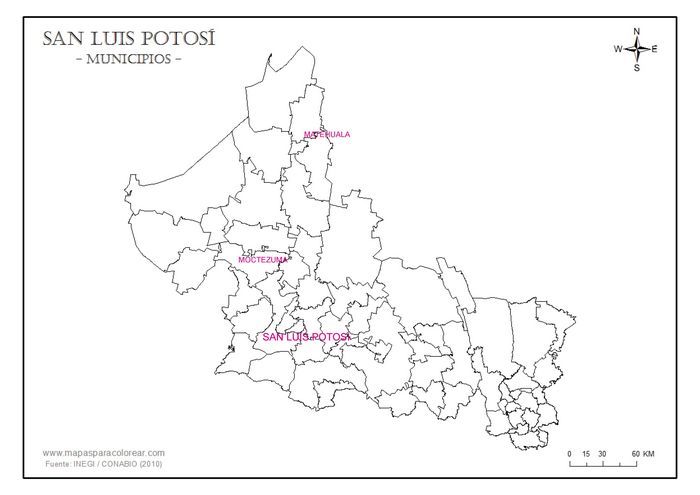 Matehuala
Matehuala
Negociación Minera Santa Maria de la Paz y Anexas
La Paz is in the Sierra del Fraile, 187 kilometres north of the city of San Luis Potosí. The mines had been worked by the same company since exploitation began in 1864.
In June 1913, seeing that there was no currency in circulation, this company, the Negociación Minera Santa Maria de la Paz y Anexas, with the consent of the Huertista government, issued 30,000 pesos in vouchers. The company took several months to arrange for a professional issue to be printed in the United States, so did it have a "provisional issue" in the meantime?
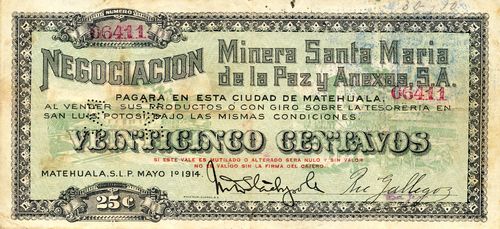
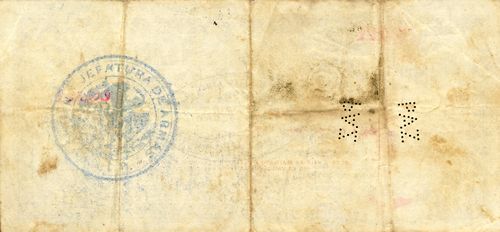 M3674b 25c Santa María de la Paz
M3674b 25c Santa María de la Paz
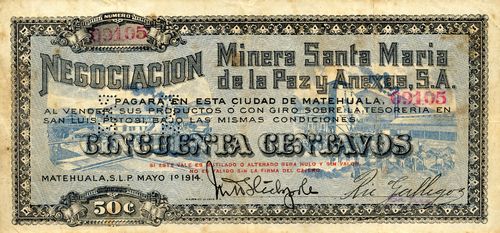
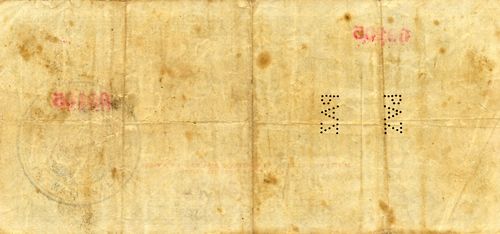 M3675a 50c Santa María de la Paz
M3675a 50c Santa María de la Paz
Some notes have an extra signature of José Granadez (with rubberstamp ‘Cajero’)
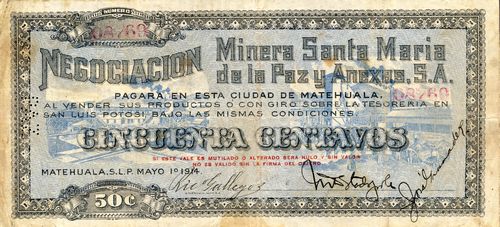
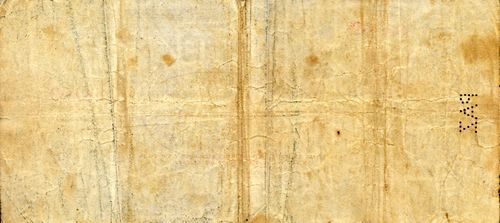 M3675b 50c Santa María de la Paz
M3675b 50c Santa María de la Paz
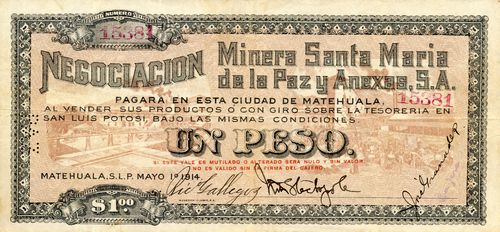
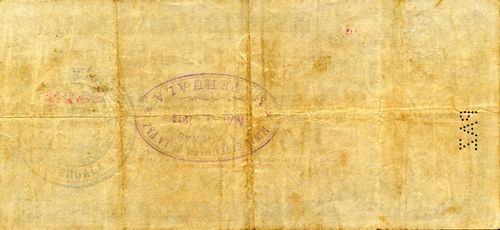 M3676 $1 Santa María de la Paz
M3676 $1 Santa María de la Paz

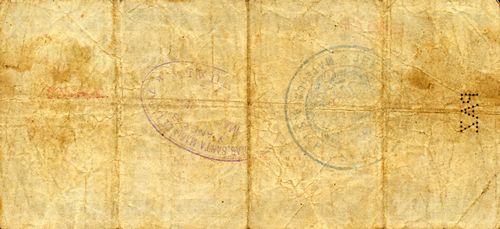 M3677 $2 Santa María de la Paz
M3677 $2 Santa María de la Paz
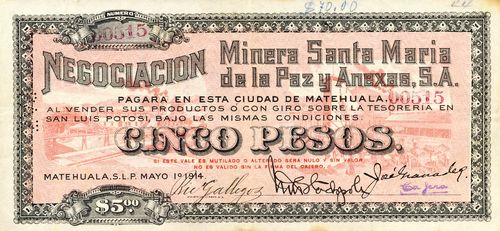
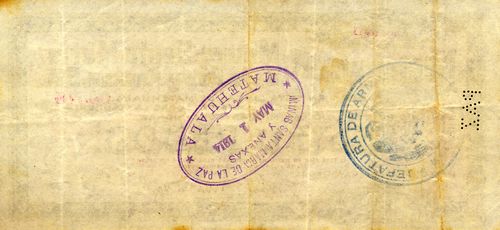 M3679 $5 Santa María de la Paz
M3679 $5 Santa María de la Paz
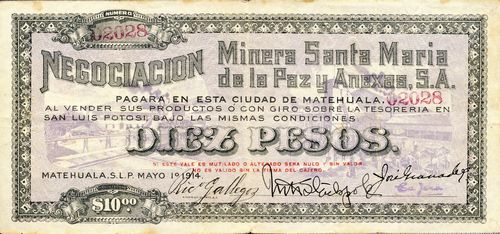
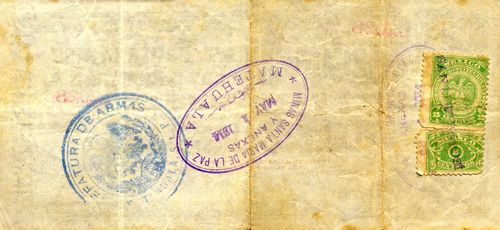 M3680 $10 Santa María de la Paz
M3680 $10 Santa María de la Paz
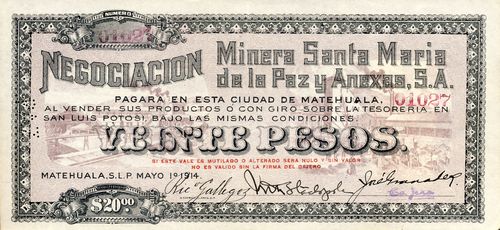
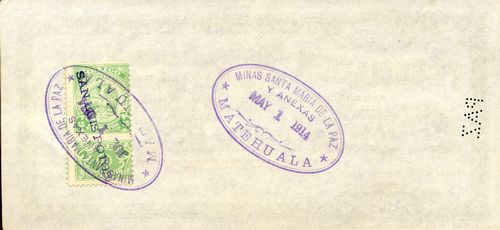 M3680b $20 Santa María de la Paz
M3680b $20 Santa María de la Paz
| date on datestamp | from | to | total number |
total value | ||
| 25c | includes numbers 05724 to 06615 | |||||
| 50c | includes numbers 08917CNBanxico #11984 to 09145 | |||||
| includes numbers 08269 to 39174 with third signature |
||||||
| $1 | 1 May 1914 | includes numbers 15268 to 15424 with third signature |
||||
| $2 | includes numbers 15518CNBanxico #6027 to 15672 with third signature |
|||||
| $5 | 1 May 1914 | includes numbers 00515 to 00548 with third signature |
||||
| $10 | 1 May 1914 | includes number 02000 to 02051CNBanxico #6029 with third signature |
||||
| $20 | 1 May 1914 | includes numbers 01004 to 01038 with third signature |
||||
| include number 01050 | ||||||
| 14 August 1914 | includes number 01067CNBanxico #6030 to 01135CNBanxico #11989 |
These notes were printed by Maverick-Clarke, printers in San Antonio, Texas, who produced the first dos caritas for Francisco Villa. They are dated 1 May 1914, payable at Matehuala, and signed by M. D. Stackpole and Richard Gallegos (as cajero). Occasionally there is a third signature.
| Manill D. Stackpole | 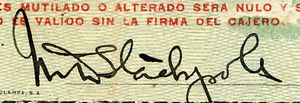 |
| Richard Gallegos | 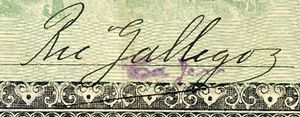 |
| José Granad[ ][identification needed] | 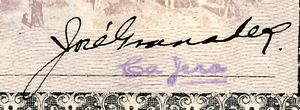 |
When the new revolutionary interim governor and Comandante Militar, Eulalio Gutiérrez, took over in July 1914, he demanded their immediate cancellation, threatening that the government would confiscate and work the mine directly if the paper currency bearing his signature, which he intended to issue but was not yet in circulation, was not used exclusivelyPRO, Record of the British Foreign Office, F0371, v2406, f23935, p23835 Sanford to the Foreign Office, 6 February 1915; ibid., p 43256 Spring Rice to the Foreign Office, 16 November 1915; ibid., v2407, n45167, 45167: Salinas of Mexico Ltd. to the Foreign Office, 16 March 1915. This might be a reference to the Brigada Alvarez notes, from nearby Matehuala, issued by Herminio Alvarez, after he became governor in October 1914.
On 14 April 1915 the Villista General Tomás Urbina, from his headquarters in Auza, San Luis Potosí, declared that the issue of notes or tickets (bonos o boletas) by foreign residents was strictly prohibited and required such foreigners to pay their workers in Mexican silver coin or American goldSD papers, 812.63/100. In fact this decree related mainly to American mining operations in Durango: Urbina, by virtue of being military commander of the State of Durango, had the power to issue such an orderEl Paso Morning Times, 5 May 1915.
Among the archives that were thrown into landfill by the new owners of the American Bank Note Company was correspondence from 1920-1921 on notes for the Negociación Minera de la Paz y Anexas in MatehulaABNC, 40332.00. This might have been for a proposed (and possibly effected) issue of low value notes, to address the same shortage as the Comisión Monetaria notes in Mexico City.
Moctezuma
Minas “Guadalupana”
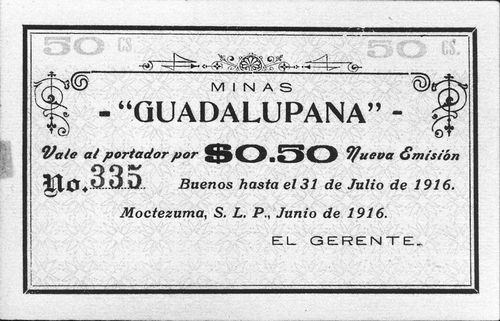 M3682 50c Minas Guadalupana
M3682 50c Minas Guadalupana
| from | to | total number |
total value |
||
| 50c | includes number 335 |
These notes for 50c in infalsificables were good for a couple of months, up to 31 July 1916.
